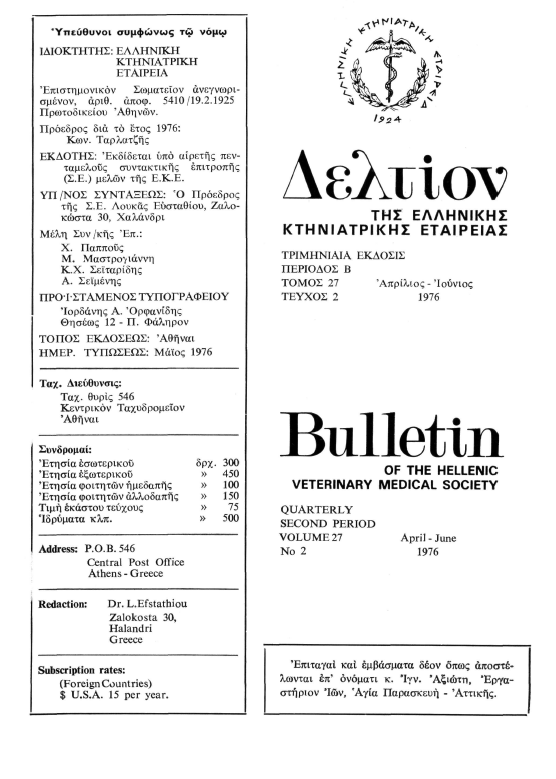Comperative study on the brucellosis among unvaccinatedand vaccinated with Rev. I. vaccine
Abstract
The present study, on the epidemiology of Brucellosis, deals with the data collected from vaccinated and unvaccinated against Brucellosis sheep herds. The study was conducted during the year 1975 and the main purpose was to investigate the extent of the disease among the unvaccinated sheep as well as among the vaccinate ones. The sheep of one village were divided into group A and Β which were raised separately. A total of 978 blood samples, concerning the whole sheep population were examined. From group A a total of 535 blood samples were examined from unvaccinated sheep and 184 (34, 40%) were serologically positive while 26 from 100 samples, obtained from vaccinate, sheep were positive (26%). From group Β a total of 289 blood samples (9%) from unvaccinated sheep, were examined and proved positive while from 54 samples from vaccinated sheep 5 (9,26%) were positive. Considering both groups (A + B) we obtained the following results. From a total of 824 blood samples, taken from unvaccinated sheep, 210 (25,5%) were positive while from 154 samples from vaccinated sheep, 31 (20,60%) were positive. In the average both vaccinated and unvaccinated sheep were positive for brucella in a percentage of 24,60%. The tube agglutination test as well as the complement fixation test were used for testing the sera. With the former method a total of 978 samples were examined and 226 were positive (24,1%). The complement fixation test was used for a total of 108 samples obtained from aborted sheep or from sheep which gave a negative result with the tube agglutination test and 15 were found positive (13,9%). Considering 80 samples obtained from aborted sheep, from which 63 refered to unvaccinated and 17 to vaccinated sheep, the positive samples were 38 (60,50%) and 10 (59%) respectively. This means that from 80 aborted sheep 48 (60%) were positive fro brucella antibodies
Article Details
- How to Cite
-
ΣΤΕΦΑΝΟΥ Δ., ΠΑΠΑΔΟΠΟΥΛΟΣ Κ. Α., ΝΑΛΜΠΑΝΤΗΣ Χ., & ΓΙΑΝΤΖΗΣ Δ. (2019). Comperative study on the brucellosis among unvaccinatedand vaccinated with Rev. I. vaccine. Journal of the Hellenic Veterinary Medical Society, 29(1), 35–44. https://doi.org/10.12681/jhvms.21332
- Issue
- Vol. 29 No. 1 (1978)
- Section
- Articles

This work is licensed under a Creative Commons Attribution-NonCommercial 4.0 International License.
Authors who publish with this journal agree to the following terms:
· Authors retain copyright and grant the journal right of first publication with the work simultaneously licensed under a Creative Commons Attribution Non-Commercial License that allows others to share the work with an acknowledgement of the work's authorship and initial publication in this journal.
· Authors are able to enter into separate, additional contractual arrangements for the non-exclusive distribution of the journal's published version of the work (e.g. post it to an institutional repository or publish it in a book), with an acknowledgement of its initial publication in this journal.
· Authors are permitted and encouraged to post their work online (preferably in institutional repositories or on their website) prior to and during the submission process, as it can lead to productive exchanges, as well as earlier and greater citation of published work.






